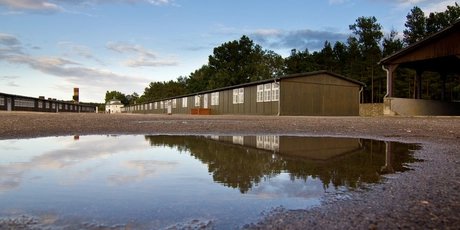
Gedenkstätte Sachsenhausen
Memorial centre and museum
The memorial centre at Sachsenhausen tells the story of one of the biggest concentration camps on German territory from 1936 to 1945.
On 21 March 1933, right in the centre of the town of Oranienburg near Berlin, an empty factory building became the first concentration camp in Prussia. Today, the memorial centre at Sachsenhausen tells the story of the concentration camp at the sites where it took place.
The concentration camp
The site of what is now the Sachsenhausen memorial centre was one of the biggest concentration camps on German territory from 1936 to 1945. The T Building housed the central administration office for all the concentration camps. The part of the camp known as the “Zone of Interest”, along with many auxiliary camps, housed around 200,000 inmates who were enslaved and exploited as forced labour by local industry. Several tens of thousands of prisoners died as a result the inhumane working and living conditions and the brutal treatment, or were gassed, shot or subjected to medical experiments.
In April 1945, with the Red Army already approaching, the SS began evacuating the camp and sent the inmates on “death marches”, in which thousands were shot or died of exhaustion. Today, a branch of the memorial centre commemorates the death march with an exhibition in Belower Wald.
On 22 and 23 April 1945, Soviet and Polish troops reached the camp, where even after liberation, hundreds died as a result of their imprisonment.
After the Second World War
From 1945 to 1950 the site was used as a special camp by the NKVD, the Soviet secret service. It was what was known as a silent camp, and around 60,000 internees lived there under the most miserable conditions. Around 12,000 of them died due to conditions in the camp, hunger and disease.

Sachsenhausen memorial centre and museum
In 1961 the site was declared a national place of memorial and remembrance in the GDR. Since 1993, the memorial centre and museum at Sachsenhausen have belonged to the Stiftung Brandenburgische Gedenkstätten, the foundation which maintains memorials in Brandenburg. In the 1990s, work began on preserving the original locations as memorials, 13 new permanent exhibitions were opened and the architect HG Merz redesigned the central place of remembrance, Station Z.
The memorial centre is an open place of learning. Rather than everything being in one place, you can walk around the original locations, the huts, the cells and the administrative centre, and find out about the concentration camp. At the visitor information centre, you are given a general suggestion of where to go, and an overview of the exhibitions. A visitor guide system provides further information and takes you to the various sites.
Information for schools
Admission to the Sachsenhausen memorial centre and the exhibitions is free. We advise school groups to take a guided tour of the camp and the museums.
As well as general guides, tours on specific topics are available. For groups of up to 15, a guided tour costs 15 euros, and 25 euros for groups of up to 30. Tours must be booked in advance.
A museum box is available for schools to prepare for the visit (suitable for pupils of 15 or older).
A guided tour and film are available if booked in advance. The museums and films are not suitable for children under 10.
